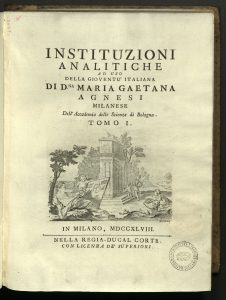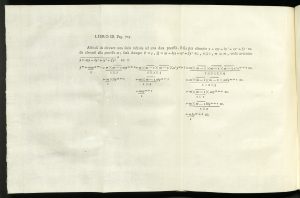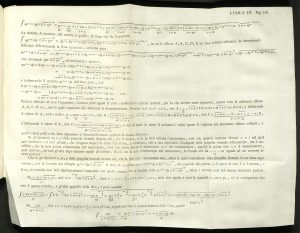Tags
algebra, Baltimore, Bologna, calculus, copper engravings, English, French, geometry, German, Greek, headpieces, Hebrew, historiated initials, Isaac Newton, Italian, John Colson, John Hellens, Johns Hopkins University Press, Latin, Leibniz, Maria Gaetana Agnesi, Massimo Mazzotti, Milan, Pietro Agnesi, Pope Benedict XIV, silk merchant, Spanish, vignettes
Instituzioni Analitiche
Maria Gaetana Agnesi (1718-1799)
Milan: Nella Regia-Ducal Corte, 1748
First edition
QA35 A27 1748
Maria Gaetana Agnesi was the eldest in a family of at least twenty-one children. Her father, Pietro Agnesi, a wealthy silk merchant, could afford to provide her with some of the best tutors available. A child prodigy, at an early age she had mastered Greek, Hebrew, French, Spanish, German and Latin.
She was shy, and suffered convulsions and headaches, but had strong impetus to please her father, who was focused on moving his family from its merchant class status to aristocracy. He proudly and frequently had her present at small social gatherings in which she gave discourses in Latin on natural philosophy — subjects such as the nature of tides and the origins of spring water –, mathematics, or the nature of the soul. These discourses took place in her well-appointed family home, surrounded by lush furnishings and paintings of sacred subjects.
Several of her sisters entered convents. One of her brothers became a monk. Pietro Agnesi denied Gaetana’s request to enter a convent, but eventually agreed to keep her out of the public sphere.
Instituzioni Analitiche is her momumental work, which she dedicated to Empress Maria Theresa of Austria. Her objective was to give a complete comprehensible analysis of algebra, with emphasis on relatively new concepts. She wrote in Italian rather than Latin in an attempt to attract younger readers (in particular her brothers) and other readers, such as women, who were less than welcome in the world of Latin scholars. She explained elementary algebra, classical geometry, differential calculus, and integral calculus. Calculus was little understood by many intellectuals, including mathematicians, of the time — Isaac Newton had only recently died in 1727, Leibniz in 1716. This was the first vernacular textbook on calculus. And the first mathematics book to be published by a woman.
In her introduction, Agnesi states that some of the methods, material, and generalizations in her book were original to her. Her book was translated into English and French. John Hellens, editor of John Colson’s English translation, noted that Colson “found [Agnesi’s] work to be so excellent that he was at the pains of learning the Italian language at an advanced age for the sole purpose of translating her book into English, that the British Youth might have the benefit of it as well as the Youth of Italy.”
Today, Agnesi’s name is known to math students for her geometric “curve,” the witch of Agnesi, expressed as a mathematical equation.
Agnesi received her greatest recognition from Pope Benedict XIV (1675-1758) in the form of two letters. The first letter (June 1749) congratulated her on the publication of her book and was accompanied by a gold wreath containing valuable stones and a gold medal. In his second letter (September 1750), the pope appointed her to the chair of mathematics and natural philosophy at Bologna. Though she accepted the position as “honorary,” she ultimately did not teach there.
Following the death of her father, she no longer engaged in any scientific activity and spent the rest of her life in religious studies, devoting herself to the poor, the sick, the hungry and the homeless. She was all but forgotten for her treatise on calculus.
Illustrated with fifty-nine copper engraved folding plates and two folding tables. Copper-engraved title page vignettes, headpieces and historiated initials. Rare Books copy bound in early nineteenth century calf over paste paper boards, green and red gilt-lettered spine labels.
Recommended reading:
Mazzotti, Massimo. The World of Maria Gaetana Agnesi, Mathematician of God. Baltimore: The Johns Hopkins University Press, 2007, QA29 A28 M39 2007, L1, General Collection




You must be logged in to post a comment.